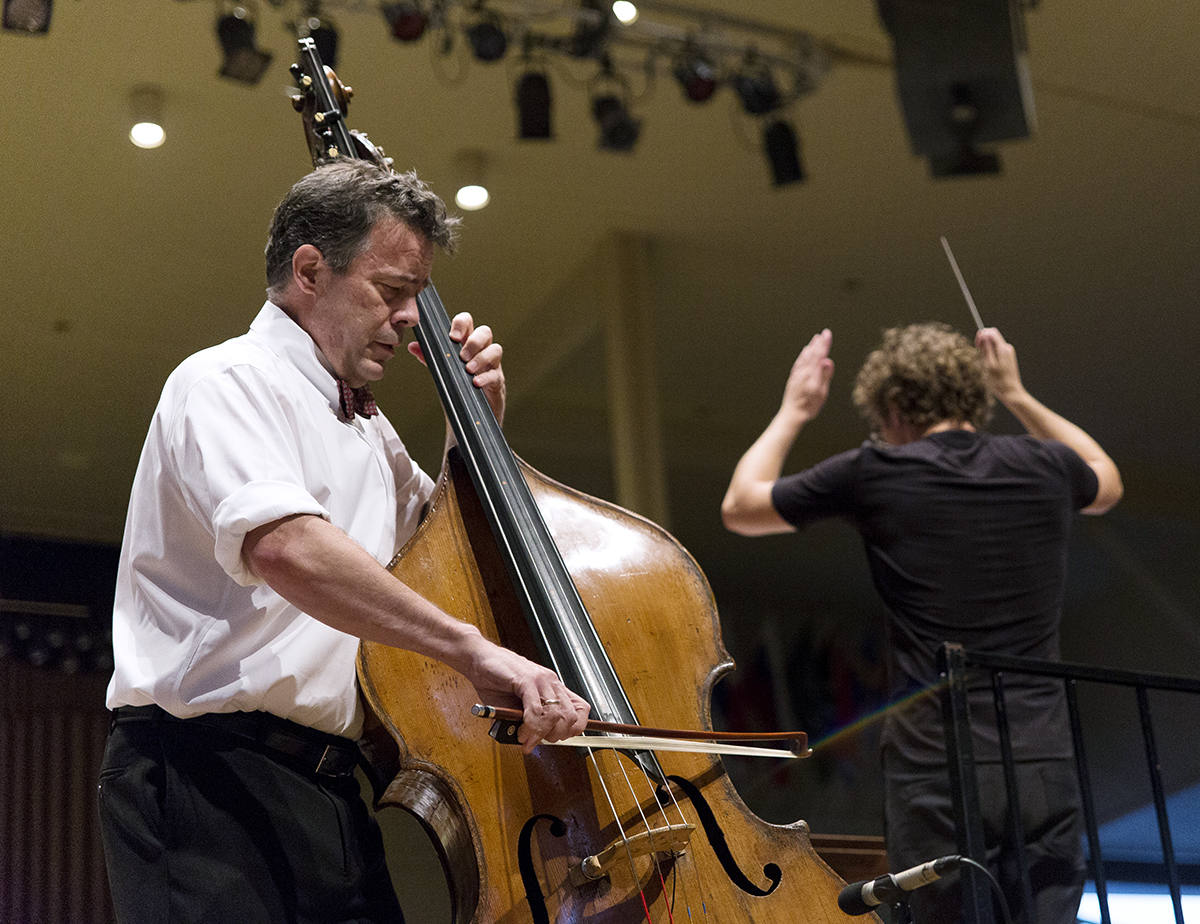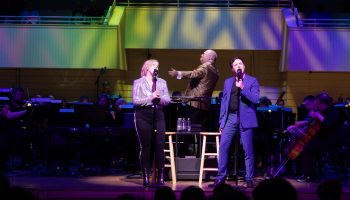When conductor Teddy Abrams was introduced at last evening’s Chautauqua Symphony Orchestra concert, there was a moment’s hesitation before the tentative applause. Perhaps the audience in the half-full Amphitheater thought the diminutive bespectacled guy in the black jeans and black T-shirt was a stagehand. Or Steve Jobs.
But the tousle-haired native of Oakland, California, is the music director of the Louisville Orchestra, an ensemble with an unparalleled legacy of advocacy of American composers. That’s material, because Abrams and the CSO played an all-American program of music by John Williams, Edgar Meyer, Aaron Copland and Abrams himself.
It’s charming to think that the conductor might have been in the theater watching the film for which John Williams wrote the music that opened the concert: “The Cowboys.” He probably watched it on VHS; the conductor wasn’t born until 15 years after the film’s 1972 release.
The concert overture fashioned from that score is Williams at his most Copland-esque, drawing heavily from the elder composer’s “Rodeo” and “Billy the Kid” ballet scores. Abrams kicked it off at a full gallop with the CSO making an appropriately big sound, but it wasn’t all high-stepping. The night-on-the-range middle section was caressed lovingly, all the more to contrast the return of the rootin’-tootin’ main theme where the brass rang out nobly, the strings sang a prairie song and the action unfolded in big-screen technicolor.
Up next was the conductor’s own “Fiddling,” a slight but ingratiating workout for strings inspired by the bluegrass music of Kentucky. It was four minutes of perpetual motion for strings, driven by Abrams’ clear and emphatic beat, delivered with big, swinging arcs of his arms.
The demotic elements of “Fiddling” were also in Edgar Meyer’s 1993 Concerto in D, which is less a concerto than a series of solos with added orchestral accents or interludes. Those episodes are fairly minimal, both in length and volume, probably out of necessity. Even though Meyer, the only soloist permitted to play the work, was amplified on this occasion (and perhaps a bit too much), the bass is an instrument that doesn’t speak loudly.
The work opened with Meyer bowing a sly, bluesy riff that wanders off into harmonically shifting territory with wispy accompanying figures that might have been inspired by those in Rodrigo’s concertos for guitar, another soft-spoken instrument. That unfolded with little rhythmic variation until the blues arrived to end the movement. The second movement ambled the Tobacco Road of a vaguely Appalachian melody before turning onto the Silk Road of the exaggerated portamento used by Indian violinists (not that easy to do on the big fiddle). The concerto concluded with a barn dance propelled by Meyer’s double-stopped bowing. Here again, Copland’s influence was heard in the irregular rhythms to which the vernacular melodies, calling for Meyer’s fanciest fingerwork of the night, were set.
The night was hot and very humid, and Meyer seemed bothered by the conditions, which are hard on string players. After bowing the last note, he immediately moved to the podium. I don’t read lips, but I imagine he told Abrams, “Wow, glad I made it through that.” The audience rewarded his exertions with an ovation almost as warm as the midsummer air, and multiple curtain calls.
The big work, Aaron Copland’s Symphony No. 3 of 1946, came highly anticipated considering Abrams’ lineage. He studied with the composer’s foremost living interpreter, Michael Tilson Thomas, who himself was a protégé of the peerless Leonard Bernstein, an early associate of the composer’s and a champion of the symphony.
Abrams started in fine style, building the great arch of the opening movement from granitic blocks of orchestral sonority. This is Copland in his most heroic mode and Abrams conducted with grand, sometimes relentless sweep, evoking Shostakovich, of all composers, in this most American of music.
In the Allegro molto second movement, Abrams drove the music purposefully, but not all of Copland’s slashing cross-rhythms were cleanly handled. The big moments — and there were a lot of them — rang out impressively.
Another unlikely composer, Gustav Mahler, was evoked in the stark string threnody that began the Andantino quasi allegretto. Even the vigorous middle portion, so reminiscent of Copland’s “Appalachian Spring,” was sometimes shot through with the eerie Alpine melancholy of Mahler’s “Wunderhorn” songs.
Out of this pastoral calm arose the famous melody of the composer’s “Fanfare for the Common Man,” here given to the winds. If there was a whiff of Old World gloom, it was blown away when the fanfare rang out in its familiar form in the brass. Once again, some of the woodwind lines in the contrapuntal variations on the fanfare weren’t clearly articulated in the winds, but the muscular climax was brought home with tremendous force.
It was a stirring, but not subtle performance, perhaps lacking the ultimate mastery of tension and release that other conductors bring to this music.
But give the kid time. He’s only 29.
John Chacona is a freelance writer and producer in Erie, Pennsylvania, who writes about culture for the Erie Times-News. Follow him on Twitter, @JohnChacona.





